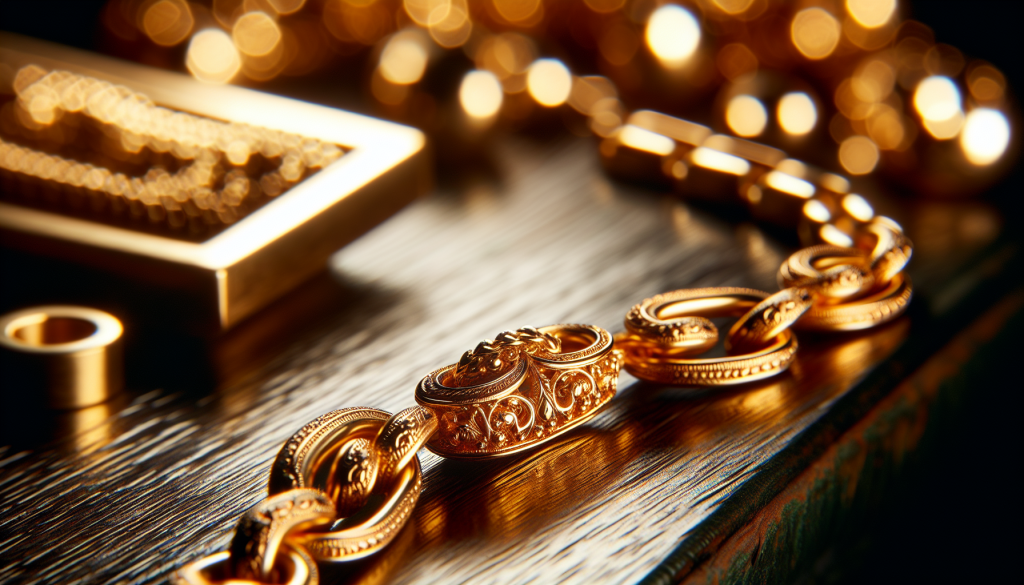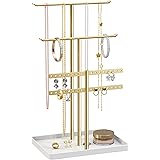Imagine the joy of adorning your wrist with a stunning gold bracelet, adding a touch of elegance and opulence to your ensemble. But have you ever wondered how much gold is actually required to create such a captivating piece of jewelry? Well, fret not, for in this article we will unravel the mystery, divulging the precise amount of gold needed to fashion a breathtaking bracelet that will leave you feeling like royalty. Whether you’re a jewelry enthusiast or simply curious about the craftsmanship behind these exquisite accessories, get ready to be enlightened on the captivating journey of gold and bracelets.
Vicoter Velvet Jewelry Box 24 Grid Jewelry Ring Display Organiser Box Tray Holder Earrings Storage Case for Girls Wife Mom Women (Pink)
$12.98 (as of December 20, 2025 19:16 GMT +00:00 - More infoProduct prices and availability are accurate as of the date/time indicated and are subject to change. Any price and availability information displayed on [relevant Amazon Site(s), as applicable] at the time of purchase will apply to the purchase of this product.)OASSIE Christmas Thank You Gifts for Women - 4"x4" Ceramic Jewelry Dish Tray - Birthday Appreciation Inspirational Gifts for Women Coworker Teacher Friends Employee Boss, Retirement Gift for Woman
12% OffHomde Synthetic Leather Huge Jewelry Box Mirrored Watch Organizer Necklace Ring Earring Storage Lockable Gift Case (White + Gold)
$49.99 (as of December 20, 2025 19:46 GMT +00:00 - More infoProduct prices and availability are accurate as of the date/time indicated and are subject to change. Any price and availability information displayed on [relevant Amazon Site(s), as applicable] at the time of purchase will apply to the purchase of this product.)pickpiff Jewelry Stand Holder Organizer: 14.5" Sturdy Hanger for 80 Pcs Jewelry, Gift for Women, Gold Jewlery Tower for Necklace, Earring, Bracelet
$17.99 (as of December 20, 2025 19:16 GMT +00:00 - More infoProduct prices and availability are accurate as of the date/time indicated and are subject to change. Any price and availability information displayed on [relevant Amazon Site(s), as applicable] at the time of purchase will apply to the purchase of this product.)Giggle & Honey Musical Jewelry Box for Girls - Kids Jewelry Box, Unicorn Toys for Girls 4-6, Unicorn Gifts, 6 x 4.7 x 3.5 in
$16.99 (as of December 20, 2025 19:46 GMT +00:00 - More infoProduct prices and availability are accurate as of the date/time indicated and are subject to change. Any price and availability information displayed on [relevant Amazon Site(s), as applicable] at the time of purchase will apply to the purchase of this product.)
Determining the Weight of a Gold Bracelet
Understanding the Karat System
When determining the weight of a gold bracelet, it is essential to have a basic understanding of the karat system. The karat system is used to measure the purity of gold, with 24 karats being the highest level of purity. However, pure gold is too soft to be used in jewelry, so it is often alloyed with other metals to enhance its strength and durability. As a result, lower karat gold contains a higher percentage of alloyed metals. By understanding the karat system, you can better determine the weight of your gold bracelet.
Choosing the Design and Style of the Bracelet
The design and style of a gold bracelet play an essential role in determining its weight. Different types of bracelets, such as bangle bracelets, link or chain bracelets, cuff bracelets, and charm bracelets, vary in weight due to their unique construction. The intricacy of the design and the presence of additional elements like gemstones, engravings, or patterns also affect the overall weight of the bracelet. Before calculating the weight, consider the design and style you prefer for your gold bracelet.
Calculating the Metal Composition
To determine the weight of your gold bracelet accurately, you need to calculate the metal composition. This involves understanding the percentage of pure gold present in the bracelet. For instance, a 14 karat gold bracelet contains 58.3% pure gold, while an 18 karat gold bracelet contains 75% pure gold. By knowing the karat value of your bracelet, you can calculate the weight of pure gold it contains.
Determining the Length and Width of the Bracelet
The length and width of a gold bracelet also contribute to its overall weight. Longer and wider bracelets tend to be heavier than shorter and narrower ones. To calculate the weight accurately, measure the length and width of your bracelet in inches or centimeters. These measurements will be crucial when determining the final weight of your gold bracelet.
Considering the Bracelet’s Thickness
The thickness of a gold bracelet also plays a role in its weight. A thicker bracelet will contain more gold than a thinner one, resulting in a higher weight. When considering the weight of your gold bracelet, take into account the desired thickness, as it will impact the final weight calculation. Keep in mind that thicker bracelets may be heavier, but they can also provide a more substantial and luxurious appearance.
Gold Density and Purity
Exploring Gold’s Density
Gold is a dense metal, with a specific gravity of 19.32. This density means that a given volume of gold will weigh 19.32 times more than the same volume of water. The density of gold is a critical factor in determining its weight, as it allows us to convert volume measurements into weight measurements accurately. By understanding the density of gold, you can calculate the weight of your gold bracelet based on its volume.
Understanding the Importance of Purity
The purity of gold is a significant factor in determining its weight. Pure gold, also known as 24 karat gold, is the most valuable and densest form of gold. However, as mentioned earlier, pure gold is too soft to be used in jewelry. Therefore, gold jewelry is typically alloyed with other metals to increase its durability. The higher the karat value of your gold bracelet, the more pure gold it contains, resulting in a higher weight.
Determining the Gold Alloy Composition
When determining the weight of a gold bracelet, it is crucial to consider the composition of the gold alloy used. Different alloys can have varying densities and weights. For example, 14 karat gold, which contains a higher percentage of alloyed metals, will weigh less than 18 karat gold, which contains a higher percentage of pure gold. Understanding the gold alloy composition is necessary for an accurate weight calculation.
Differentiating between Pure Gold and Gold Alloys
It is important to differentiate between pure gold and gold alloys when calculating the weight of a gold bracelet. Pure gold, as previously mentioned, has a density of 19.32 g/cm³. However, the density of gold alloys can vary depending on the specific combination of metals used in the alloy. Gold alloys with a higher percentage of pure gold will have a density closer to that of pure gold, while alloys with a lower percentage of pure gold will have a slightly lower density.
Calculating the Gold Weight Based on Karat
Converting the Karat Value to a Percentage
To calculate the weight of pure gold in your bracelet accurately, you need to convert the karat value to a percentage. For example, 14 karat gold is 58.3% pure, while 18 karat gold is 75% pure. To obtain the percentage of pure gold, simply divide the karat value by 24. This resulting percentage will be used in further calculations to determine the weight of pure gold.
Determining the Weight of Pure Gold
Once you have obtained the percentage of pure gold, you can determine the weight of pure gold in your bracelet. Multiply the weight of the entire bracelet by the percentage of pure gold obtained earlier. For example, if your bracelet weighs 30 grams and is made of 14 karat gold (58.3% pure), you would multiply 30 grams by 0.583 to find that it contains approximately 17.49 grams of pure gold.
Accounting for the Tare or Wastage Factor
When calculating the gold weight, it is important to consider the tare or wastage factor. The tare factor accounts for any loss of gold during the jewelry-making process, such as filing, soldering, or polishing. This factor varies depending on the jeweler and the complexity of the design. To determine the final weight of your gold bracelet, subtract the tare factor from the weight of pure gold obtained earlier.
Calculating the Final Gold Weight
To calculate the final weight of your gold bracelet, subtract the tare factor from the weight of pure gold. This will give you the net weight of gold in your bracelet. For example, if your bracelet contains 17.49 grams of pure gold and the tare factor is 1 gram, the final gold weight of your bracelet would be approximately 16.49 grams.
Factors Affecting the Gold Weight
Adding Gemstones or Accents
When adding gemstones or other accents to your gold bracelet, the weight of these elements must be considered separately. Gemstones vary in density, so their weight will depend on the type and size of the stones used. Additionally, any other decorative accents, such as diamonds, pearls, or enamel, will add to the overall weight of the bracelet. Consider these factors when determining the total weight of your gold bracelet.
Including Engravings or Patterns
Engravings or intricate patterns on a gold bracelet can contribute to its overall weight. The depth and intricacy of the engravings or patterns will determine the additional weight. While the weight added through engravings may be minimal, it is still relevant when calculating the total weight of the bracelet. Take into account any engravings or patterns when determining the weight of your gold bracelet.
Considering Additional Reinforcements
Some gold bracelets may require additional reinforcements for added strength and durability. These reinforcements, such as hidden clasps or extra links, can add to the overall weight of the bracelet. If you choose a bracelet design that requires extra reinforcements, keep in mind that it may increase the weight of your gold bracelet.

Average Gold Weight for Popular Bracelet Types
Bangle Bracelets
Bangle bracelets are typically solid and can have various thicknesses. On average, a gold bangle bracelet may weigh anywhere between 5 to 20 grams, depending on the design and the karat value of the gold. Thicker bangle bracelets will generally weigh more than slimmer ones due to the increased volume of gold used.
Link or Chain Bracelets
Link or chain bracelets consist of multiple interconnected links, and their weight will depend on the length and width of the bracelet. On average, a gold link or chain bracelet may weigh between 5 to 15 grams, again depending on the design and karat value of the gold.
Cuff Bracelets
Cuff bracelets are typically wider and thicker, giving them a more substantial weight compared to other bracelet types. On average, a gold cuff bracelet may weigh anywhere between 15 to 30 grams, depending on the karat value and the presence of any additional elements like gemstones or engravings.
Charm Bracelets
Charm bracelets are unique in that they allow for the addition of various charms and pendants. The weight of a gold charm bracelet will depend on the number and size of the charms attached. On average, a gold charm bracelet may weigh between 10 to 25 grams, considering an average number of charms.
The Impact of Bracelet Size
Determining the Inner Circumference
To determine the weight of a gold bracelet accurately, it is essential to consider its size. Begin by measuring the inner circumference of the bracelet using a tape measure or a flexible ruler. This measurement will give you an idea of the amount of gold used in the bracelet’s construction.
Calculating the Outer Circumference
The outer circumference of a gold bracelet is another factor to consider when calculating its weight. The outer circumference takes into account the thickness of the bracelet. To calculate the outer circumference, add the thickness of the bracelet to the inner circumference measurement obtained earlier. This measurement will provide a more accurate estimation of the weight of your gold bracelet.
Converting Circumference Measurements to Length
Once you have determined the inner and outer circumferences of your gold bracelet, you can convert these measurements to length. This is done by dividing the circumferences by the mathematical constant Pi (approximately 3.14159). By converting the measurements to length, you can easily compare the size and weight of different gold bracelets.
Considering the Bracelet Width
In addition to the length, the width of a gold bracelet also plays a role in its weight. A wider bracelet will contain more gold, resulting in a higher weight. When determining the weight of your gold bracelet, take into account both the length and the width, as they will contribute to the overall weight.

Other Metals and Materials
Adding Alloy Metals for Durability
Gold is often alloyed with other metals to enhance its durability and strength. These alloy metals, such as copper, silver, or palladium, are mixed with gold to create different gold alloys. The addition of alloy metals can affect the weight of the bracelet, as different metals have varying densities. Consider the presence of alloy metals when determining the weight of your gold bracelet.
Exploring Popular Metals for Bracelet Making
While gold is a popular choice for bracelets, other metals and materials are also used in bracelet making. These metals, such as silver, platinum, or stainless steel, have different densities and weights. When considering a non-gold bracelet, keep in mind the weight associated with the specific metal or material used.
Considering Gold Plating or Vermeil
Gold plating or vermeil refers to a thin layer of gold applied to another metal. The weight of gold plating or vermeil is minimal compared to solid gold, as the gold layer is relatively thin. If you opt for a gold-plated or vermeil bracelet, keep in mind that the weight of the gold layer will be less significant compared to solid gold.
Gold Markets and Pricing
Understanding Gold Market Prices
Gold, like other commodities, has market prices that fluctuate based on supply and demand. These market prices are essential to consider when determining the value of your gold bracelet. Stay informed about the current gold market prices to have a better understanding of the potential cost associated with your bracelet.
Exploring the Current Gold Price per Ounce
The weight of your gold bracelet is closely correlated with its value. To determine the cost of your bracelet, it is important to keep track of the current gold price per ounce. Jewelers and gold traders typically base their pricing on the current market price, taking into account the weight and purity of the gold used.
Impact of Gold Supply and Demand
The supply and demand of gold can greatly influence its market price. Events such as economic fluctuations, geopolitical tensions, or changes in investor sentiment can impact the demand for gold, thus affecting its price. When determining the weight and cost of a gold bracelet, it is important to consider the current supply and demand dynamics of the gold market.
Additional Factors Affecting Metal Prices
While supply and demand are primary factors affecting gold prices, other factors can also contribute to price fluctuations. These factors include currency exchange rates, inflation rates, mining and production costs, and central bank policies. Stay informed about these additional factors to gain a comprehensive understanding of gold prices and the potential cost of your bracelet.

Workmanship and Additional Costs
Considering the Jeweler’s Labor Cost
The labor cost associated with crafting a gold bracelet is an important consideration when determining its final cost. Highly skilled jewelers invest time and effort into creating intricate designs and ensuring quality craftsmanship. The complexity of the design and the amount of labor involved can significantly impact the overall cost of the bracelet. Remember to factor in the jeweler’s labor cost when estimating the cost of your gold bracelet.
Incorporating Design Complexity
Design complexity refers to the level of intricacy and detail involved in the bracelet’s design. Bracelets with complex designs, such as those featuring intricate patterns or unique settings for gemstones, require additional time and expertise to create. As a result, bracelets with more complex designs may have a higher overall cost compared to simpler designs.
Factoring in Additional Materials and Gemstones
If your gold bracelet includes additional materials, such as gemstones, diamonds, or pearls, these elements will contribute to the overall cost. The weight and quality of these materials will vary, impacting the final price of the bracelet. Consider the cost of any additional materials or gemstones when estimating the cost of your gold bracelet.
Understanding Customization and Branding Costs
Customization and branding can also affect the cost of a gold bracelet. Customizing your bracelet with personalized engravings, initials, or specific symbols adds a unique touch but can incur additional costs. Similarly, designer or branded bracelets may have a higher price tag due to the brand’s reputation and exclusivity. Take customization and branding into account when considering the cost of your gold bracelet.
Conclusion
Determining the weight of a gold bracelet involves considering various factors such as the karat value, design, metal composition, length and width, thickness, gemstones or accents, and additional reinforcements. By understanding the gold density, purity, and the calculations based on the karat value, you can accurately estimate the weight of pure gold in your bracelet. The size, including the inner and outer circumference and width, also plays a role in the weight calculations. Other metals, materials, market prices, labor, design complexity, and customization also impact the overall cost of the bracelet. By considering all these factors, you can make an informed decision when purchasing or designing a gold bracelet that suits your style and budget.































